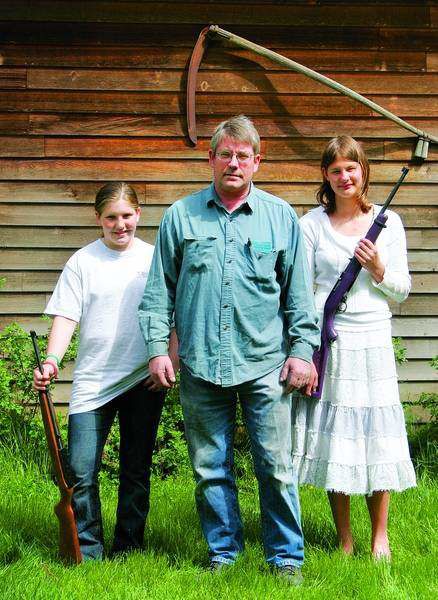Girls stick to their GUNS
Published 5:00 am Monday, May 29, 2006

- Bend gunsmith Jeff Haller, center, is pictured with his daughter, Jerricha, 14, left, and a family friend, Angelica Tackett, 13, right, at Haller's home and gunsmith shop. Haller retrofits firearms to fit women, who increasingly are buying and using firearms.
In the cab of a Chevrolet pickup littered with ammunition, shooting targets and firearms stowed behind the seat, Jeff Haller explains why more women are getting into the sport of shooting: for the same reasons as men.
”It’s just fun,” Haller said. ”It’s an adrenaline rush – you are in control of a massive amount of power.”
Haller’s business, Jeff’s Gunsmithing, began when he started repairing firearms 30 years ago. Since then, he’s seen a male-dominated sport attract increasing numbers of women. As a result, gun manufacturers are developing special guns for women and gunsmiths are adapting normal-sized guns to fit female owners.
Besides the sheer fun of it, many women are buying guns for self-defense, Haller said.
”When I first started, I never saw a woman buy a self-defense weapon,” Haller said. ”Now they regularly come to me, and I see a lot of men coming in saying their wives want a handgun for safety. So I give them advice on where to get them.”
Haller’s experience reflects a trend throughout the country. Female consumers are expected to spend $420 million on firearms, ammunition and related gear this year, according to the Newtown, Conn.-based National Shooting Sports Foundation.
According to the foundation:
* Overall, hunting and firearms sales are a $2.9 billion-per-year industry;
* While women only comprise 15 percent of the total sport-shooting market, female participants increased 50 percent between 1999 and 2004; and
* In Oregon, 15 percent of firearms hunters are women, while nearly 20 percent of handgun target shooters are women.
Neither the foundation nor Oregon Department of Fish and Wildlife has data specific to Central Oregon.
Though women hunters remain the minority, the firearms industry sees them as a lucrative market because of their increasing numbers.
As a result, gun manufacturers are developing lighter and shorter shotguns and handguns for women who find it difficult to use a regular-sized gun. While no gun manufacturers exist in Central Oregon, local gunsmiths are seeing more female customers request alterations.
Haller often adjusts firearms to fit female customers. While women only make up about 3 percent of his customers, their numbers are rising.
”Ten years ago, I saw an average of one woman (customer) a year,” Haller said. ”Now I’m seeing approximately six to 10 per year, which is a massive increase.”
Bend resident Wendy Andersen, 22, has been shooting since her dad taught her her how at age 6. She doesn’t have a problem holding her 20-gauge shotgun, but admits bigger guns are awkward to hold.
”My boyfriend has a bigger shotgun and the kick knocks me over,” Andersen said. ”A 20-gauge doesn’t have hardly any kick.”
Weight is a big issue since the heavier guns are harder to hold, she said. Andersen said she can’t complain about using firearms that may feel uncomfortable at first – she gets used to it.
That’s the mistake many firearm owners make, Haller said.
”Most people just adjust themselves, not knowing a bad fit can really affect your shot,” Haller said. ”But people don’t even think about it.”
Guns aren’t as versatile as many may think, Haller said. Holding up a rifle, he explains that it’s made for a 5-foot-8 male who weighs 150 pounds. Anyone who doesn’t fit that size will find the gun difficult to use.
Besides body size, women have other issues with firearm fitting.
”Because of the breasts, the pectoral muscle area is further above the shoulder bones,” Haller said. ”So the gun won’t sit quite right.”
Women also tend to have less developed pectoral muscles, so recoil can bruise the shoulder.
He’s found that cutting the stock at an angle helps, so that when the gun is fired, the recoil pushes at an angle, away from the body and off the shoulder.
For the best fit, women should take their own firearms to a gunsmith, Haller said.
At Bend’s The Rifle Shop Gunsmithing, owner Tom Wills said he’s done a variety of alterations for female gun owners, though the number of female customers is consistently low.
”On handguns, some women find they don’t have enough strength to pull a stiff trigger, I re-do the springs in them to lighten the trigger pull,” Wills said. ”Rifles and shotguns are mostly made for men, so we end up having to cut and shorten the stocks on them to fit smaller-stature people.”
Rifles can cost $450 to upward of $900, Wills said. Having a gun adjusted for fit, such as getting the butt stock shortened, costs $80.






